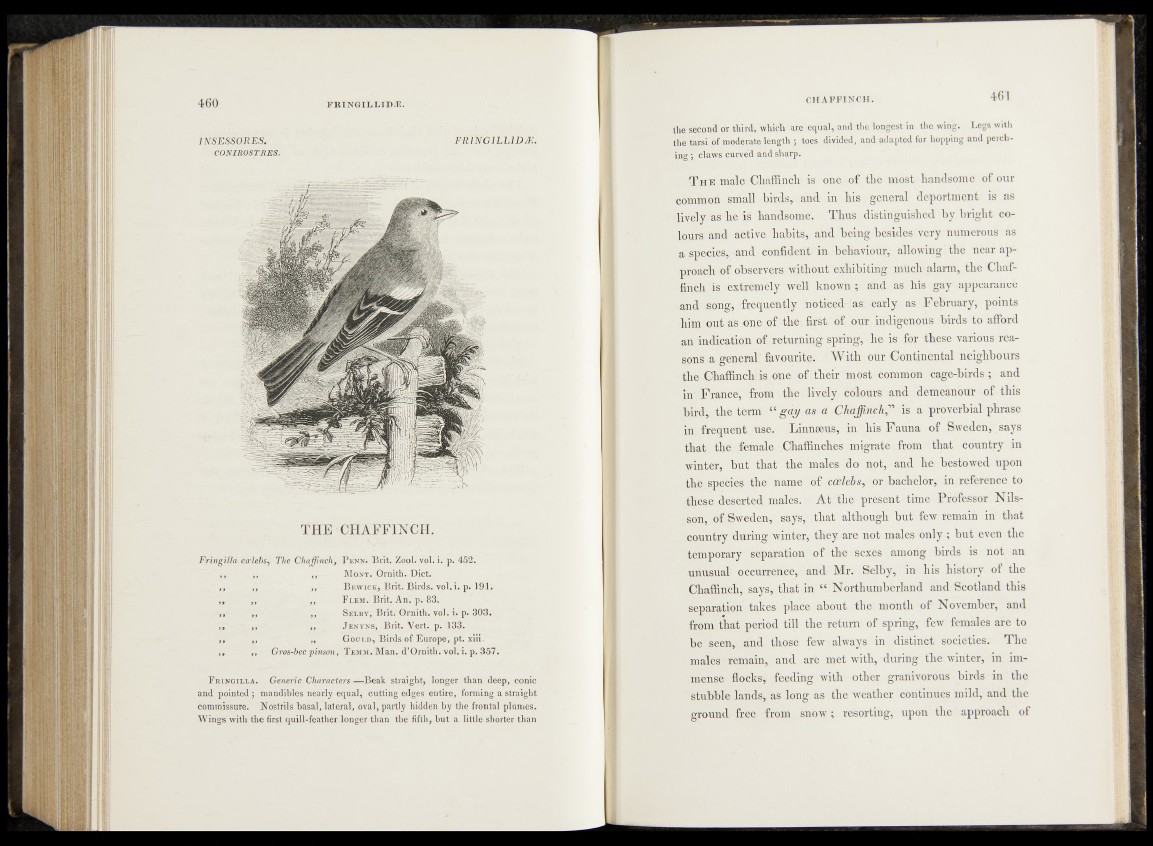
1NSESSORES. FR1NG1LL1D/E.
CONIROSTRES.
TH E CHAFFINCH.
Fringilla ctrlebs, The Chaffinch, P enn. Brit. Zool. vol. i. p. 452.
,, ,, ,, Mont. Ornith. Diet.
,, ,, ,, B ewick, Brit. Birds, vol. i. p. 191.
,, ,, ,, F lem. Brit. An. p. 83.
,, ,, ,, Selby, Brit. Ornith. vol. i. p. 303.
,, ,, ,, J enyns, Brit. Vert. p. 133.
,, ,, „ G ould, Birds of Europe, pt. xiii.
,, ,, Gros-bec pinson, T emm. Man. d’Ornith. vol. i. p. 357.
F ringilla. Generic Characters-—Beak straight, longer than deep, conic
and pointed ; mandibles nearly equal, cutting edges entire, forming a straight
commissure. Nostrils basal, lateral, oval, partly hidden by the frontal plumes.
Wings with the first quill-feather longer than the fifth, but a little shorter than
the second or third, which are equal, and the longest in the wing. Legs with
the tarsi of moderate length ; toes divided, and adapted for hopping and perching
; claws curved and sharp.
T h e male Chaffinch is one of the most handsome of our
common small birds, and in his general deportment is as
lively as he is handsome. Thus distinguished by bright colours
and active habits, and being besides very numerous as
a species, and confident in behaviour, allowing the near approach
of observers without exhibiting much alarm, the Chaffinch
is extremely well known ; and as his gay appearance
and song, frequently noticed as early as February, points
him out as one of the first of our indigenous birds to afford
an indication of returning spring, he is for these various reasons
a general favourite. With our Continental neighbours
the Chaffinch is one of their most common cage-birds ; and
in France, from the lively colours and demeanour of this
bird, the term “ gay as a Chaffinch,'1'1 is a proverbial phrase
in frequent use. Linnaeus, in his Fauna of Sweden, says
that the female Chaffinches migrate from that country in
winter, but that the males do not, and he bestowed upon
the species the name of ccelebs, or bachelor, in reference to
these deserted males. At the present time Professor Nilsson,
of Sweden, says, that although but few remain in that
country during winter, they are not males only; but even the
temporary separation of the sexes among birds is not an
unusual occurrence, and Mr. Selby, in his history of the
Chaffinch, says, that in “ Northumberland and Scotland this
separation takes place about the month of November, and
from that period till the return of spring, few females are to
be seen, and those few always in distinct societies. The
males remain, and are met with, during the winter, in immense
flocks, feeding with other granivorous birds in the
stubble lands, as long as the weather continues mild, and the
ground free from snow; resorting, upon the approach of